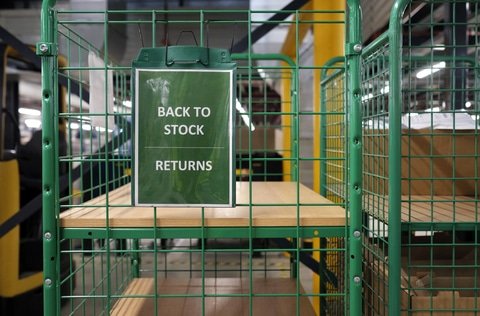While eCommerce Is the Biggest Problem, the Waves Crash over In-Store Sales, Too
Want more customers than returns this holiday season? Then companies need to get their reverse supply chains ready for the storm.
Because sometime around when they box up their decorations, shoppers flood back to online and physical stores. This late December-early January rush of returned products often overwhelms returns processing systems. And bad experiences often leave customers with the desire to shop elsewhere next time.
Such is the peril of waiting until the fall to begin thinking about how to handle returned goods. Or just assuming current reverse logistics process failures are the cost of doing business.
But those costs are only increasing. And if you wait, the tsunami may overwhelm you in just a few months.
The right strategy, returns data and system can transform the cost of returns into a competitive advantage that will have customers back for more purchases.
But operations teams need to start now.
Because a well-oiled reverse supply chain isn’t built in a quarter.
The Return Problem Is Bigger Than You Think
Online returns are growing.
The National Retail Federation pegged 2024 totals at $890 billion, or 16.9% of all annual sales. Researchers at Capital One reported eCommerce business returns increased 39.2% last year to 24.5%. Returns of apparel, often for size, fit and color, can approach 30%.
Each one chips away at margins through restocking, repackaging, customer service handling and lost inventory value.
To make matters worse, retailers and logistics providers often treat returns like they’re just the opposite of forward logistics.
They’re not. Returns involve different rules, different timelines and a different level of customer expectation.
Customers want instant refunds. Businesses want minimal cost. And both want sustainability. Because returns are wasteful and expensive. Landfilling or destroying returned goods costs money and damages corporate sustainability credentials.
A robust reverse supply chain reduces waste by routing returns to recommerce, refurbishment or appropriate liquidation channels. That means fewer items destroyed, more materials reused and a greener supply chain overall.
Those are tall orders without a modern, efficient reverse supply chain.
Optimizing Returns as a Revenue Opportunity
Traditionally, companies viewed returns as a sunk cost.
Today, the smartest businesses see them as a value stream. A return is a chance to resell, repair restock – and better yet, learn.
Leading reverse supply chain platforms deliver unit-level data and analytics that pinpoint why items are coming back. Maybe 12% of your returns are for a pink shirt that was marketed as red. Maybe 20% are coming back due to holes in collars, a packaging or quality control issue. These insights let you fix the root cause, reduce future returns and drive brand trust.
In fact, the right reverse supply chain systems help companies boost customer satisfaction by 15%–25% and increase profitability up to 5%.
Yes, supply chain processes and systems do that by reducing costs. But managing returns right can unlock faster resale, improve product grading and please customers to the point where they purchase again.
And again. And again.
Why Acting Now Matters
But by the time summer wraps up, it’s too late to transform returns logistics.
Supply chain management teams will be scrambling for Q4 preparation. Perhaps they’ll try to duct tape a broken system that they never designed for scale. Or just expect their forward-thinking warehouse management system to handle things.
These are not valid options, whatever your company’s return rates.
Building a returns-ready reverse supply chain means integrating with your current fulfillment stack. Your teams must establish efficient return flows and work with a partner who can handle it all – from printing shipping labels to liquidating items at maximum ROI.
Delaying these upgrades into Q3 or Q4 risks revenue, reputation and customer loyalty.
What a Modern Reverse Supply Chain Should Look Like
An enterprise-grade reverse supply chain must orchestrate the entire journey.
Customers return the item to the store or, if eCommerce, use a branded, easy-to-use portal.
From there, intelligent routing logic kicks in, directing items based on their condition, location and resale potential. This ensures cost-effective handling and shipping.
Once received, the returned products go through automated inspection and grading processes to determine their most valuable next step. Product condition, geography and resale potential all play a part. Items could be resold, refurbished or returned to the original vendor.
Throughout this journey, real-time analytics offer deep insights into return trends. Real-time dashboards show which items return the most, which channels underperform and what return reasons dominate.
Meanwhile, automated notifications and fast refunds make the process seamless for the buyer. And data show that the easier the returns process, the more likely buyers return.
These capabilities are available today for Tompkins Ventures clients. Tompkins Ventures can connect you with end-to-end returns management systems customized for retailers, 3PLs and manufacturers alike.
For 3PLs and Brands, Returns Are a New Profit Engine
Third-party logistics (3PL) providers have a massive opportunity in reverse logistics. Returns generate 2–5x more revenue per unit than outbound fulfillment. With the right system, a 3PL can:
- Capture margin on every shipping label generated.
- Automate return methods to cut down on labor and touchpoints.
- Provide order tracking, repair services and real-time disposition.
- Win new business by offering a full reverse logistics package – something many retailers can’t handle internally
And for brands, especially in fast-moving categories like fashion or electronics, the value is even greater. Restocking and reselling returned items within 24 hours, rather than 30 days, frees up cash flow and reduces markdowns.
The Bottom Line on Reverse Supply Chains
Returns are no longer a back-office issue. They’re a strategic opportunity that affects revenue, customer retention and supply chain efficiency. But getting it right means acting now, not scrambling in November. Whether you’re a retailer, brand manufacturer or 3PL, building a modern reverse supply chain today will protect your margins and grow your market share.
And if you connect with Tompkins Ventures, your company can have it all ready before the return rush hits. Industry-leading partners can help you design and implement a premier reverse supply chain that scales with your business. Whether you need end-to-end reverse supply chain technology, recommerce integration or analytics-driven decision support, don’t wait until it’s too late.
Related Reading
- Reverse Logistics is Really a Different Omnichannel
- Customers Need Easy Returns. Tompkins Delivers Seamless Reverse Logistics.
- The Cost of Doing Nothing About Supply Chain Risk

Tompkins Ventures matches your enterprise’s challenges with our network of 1000s of Commercial Partners, Capital Partners and Consulting Partners. Our toolbox is unlimited, as every Tompkins Ventures Partner has decades of experience helping companies address the five major factors for business success: Leadership, Capital, Technology, Supply Chain/Facilities and Procurement. In today’s business environment of continual disruption, even the best companies do not do everything great. Your core competency is your business. Our core competency is selecting the right Partner(s) to work with your executive teams to make good companies great. Business strategy and supply chain expert Dr. James A. Tompkins founded Tompkins Ventures in 2020. Our network is based in the U.S. but operates on all continents except Antarctica.

